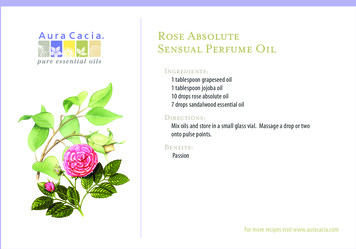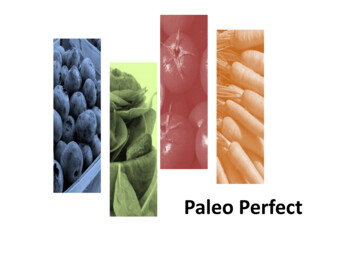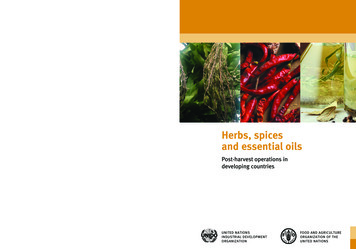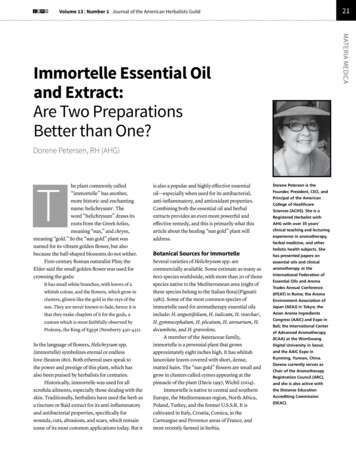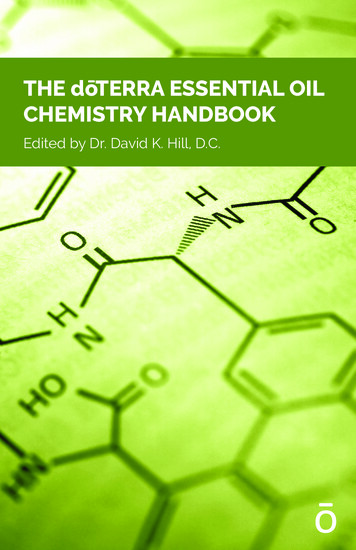
Transcription
Chapter 1: An Introduction to Essential OilsTHE dōTERRA ESSENTIAL OILCHEMISTRY HANDBOOKEdited by Dr. David K. Hill, D.C.3
Chapter 1: An Introduction to Essential OilsTABLE OF CONTENTSFOREWORD.iTHE dōTERRA OIL CHEMISTRY WHEEL.iiPART 1: THE BASICS OF ESSENTIAL OIL CHEMISTRY.21. An Introduction to Essential Oils.31.1 What are essential oils?. 3 Essential oils are called “essential” because they are the“essence” of a plant. 3Why do plants produce essential oils?. 31.2 Obtaining Essential oils from plant parts. 3 Steam Distillation. 3Cold Press. 4Solvent Extraction. 41.3 Essential Oils are complex mixtures of aromatic compounds. 4 Essential oils are made of volatile aromatic compounds. 4Essential oils can be made up of anywhere between 1and 1000 different compounds with different chemicalidentities. 52. Essential Organic Chemistry. 62.1 Oil usage is linked to oil chemistry.62.2 The carbon backbone.6 Terpenes. 7Monoterpenes.8Sesquiterpenes.82.3 Introduction to Functional Groups.93. The Functional Groups and their Functions. 103.1 Alcohols.113.2 Aldehydes.123.3 Alkenes.13
Foreword3.4 Esters.133.5 Ethers.153.6 Ketones.163.7 Phenols.173.8 Phenylpropenes.183.9 Conclusion.19FOREWORDDear friends,I, like you, have a passion for essential oils. They have played asignificant role in both my professional and personal life for manyyears. I remain convinced that the benefits of essential oils arePART 2: OIL CHEMISTRY A-Z.20unique and almost universally applicable to all who choose toArborvitae – Blue Tansy . 22Cardamom – Clary Sage. 24Clove - Dill. 26Douglas Fir – Ginger. 28Grapefruit – Lemon.30Lemongrass – Myrrh. 32Oregano – Rose. 34Rosemary – Spikenard. 36Tangerine – Ylang Ylang. 38experience them.I am so pleased to be a part of dōTERRA and to participate in theprogress and discovery of essential oils. They have found theirrightful place in science, healthcare, and most importantly, inindividualized approaches to health and wellness. Through my ownexperience, I have learned the importance of quality, and I think itis significant that dōTERRA stands alone as the sole provider of thehighest quality essential oils in the world.PART 3: CONSTITUENT CHEMISTRY.41It is my pleasure to introduce to you the dōTERRA Essential OilAnethole - Bisabolene. 42Bornyl Acetate - Carvone. 44beta-Caryophyllene - Cinnamaldehyde.46Cinnamyl Acetate - Curcumene. 48Curzerene - Farnesene.50Fenchone - Guaiene. 52Guaiadene - Jatamansone. 54Khusimol - Lindestrene.56Menthol - Myrcene.58Neral - Patchoulol.60Alpha-Phellandrene - Sabinene. 62gamma-Terpinene - Thujopsene.64Thymol - Zingiberene.66Chemistry Handbook. I am confident that it will help you expandyour knowledge of essential oils and empower you to use themmore effectively. It is my sincere desire that this chemistrycompendium will enhance your own experience, providing youwith the basic framework from which you can develop your ownpersonalized model of self-care and affording you the opportunityto share dōTERRA essential oils with others more meaningfully andin a way that is scientifically correct.With kindness,Dr. David Hilli
The doTERRA Oil Chemistry WheelTHE dōTERRA OILCHEMISTRY WHEELOil Chemistry WheelCloveCilantronesneGIZINGtoERSabineneBlue hMeLemonCglasDou irFNGLLinenebeta-Ptry wheels are presented in the following pages.TIg s,olsconstituents listed under each oil. The four sides of the two chemis-R R A H o ldi noheLIFned o-T EAnetholerv otenpe17Alcnoer20lThymoPhenylpropenesKeMo itruefaprGUPorganized by functional group, with the top one or two chemicaloninegerTanthat have a 15-carbon backbone) on one side, with a legend on theopposite side. In each of the chemistry wheels, the oils are furtherLi mwheel contains information about oils high in sesquiterpenes (oilsolsenPhMonoterpeneBackboneWild OrangeoanegOrlcrorvaCaBergamotof the monoterpene wheel describes oils with lifting properties, andthe other side presents oils with leveling properties. The secondDecenaleshydedAleach with two sides. The first wheel gives information on oils highin monoterpenes (oils that have a 10-carbon backbone). One sideCuminallraCabenefit.The dōTERRA Oil Chemistry Wheel is now divided into two ully understand when and how to use the oils to achieve a desiredsaiselMviduals better understand the chemistry behind essential oils. In understanding the basic chemistry of each oil, individuals can moreCassiaonnamCinThe dōTERRA Oil Chemistry Wheel is a tool designed to help indi-GCuminRESTORINThe oils in the dōTERRA Chemistry Wheels are grouped accordingto their shared key properties. The shared key properties provide astarting point for understanding how to use the oils. The combination of these different groupings enables individuals to begin to understand the characteristics and properties of dōTERRA’s amazingessential oils.iiRestoring: These are oils for emotional and physical support. They aremeant to help revive, strengthen, and rejuvenate the body and the senses.Uplifting: These oils are meant to be inspiring. They encourage feelings ofexhilaration, refreshment, and enlivening.Energizing: These oils are used to bring feelings of motivation andactivation. They tend to be brisk, naturally stimulating oils that help wakeup the mind and body.RED LINE DIE CUTiii
The doTERRA Oil Chemistry WheelOil Chemistry WheelRESTORINGArborvitaeWingre terenet aylalLi grtitPeNLi n a l o o lnsal,eikSpLlooinaLMd o-T ER R A H o ldi ng s,t alo lLLCoAlchomol17tae4-20S an esontKeBergamotteh olspi nYIM(Te elaa leuTr arMsEsterRomanChamomileneedrea-CalphonePatcho ulolPatchouliGINC e dr olverLLGermacrene DhMyrhg s,YlangYlangMth ethuja ylteR R A H o ldi nMethyl-amylangelateZingiblsBirchd o-T squSeacMonoterpenealpha-Pineneio lARn-nylBor errylNe tateeactersEsl, G eAl20INGrgeyhrlic meuH sMonoterpeneBackboneCi t r o n e l l oCLumaniGerMethyl salicylates 1,8SOSandalwoodOil Chemistry WheeltiVedwooCedarLIZS TA B IINGRestoring: These are oils for emotional and physical support. They aremeant to help revive, strengthen, and rejuvenate the body and the senses.Soothing: These are oils that help ease and alleviate issues, both emotionaland physical. They are meant to reassure and console as needed.Clarifying: As the name implies, these are oils that help to “make clear.”Topically they are used for improved skin tone and appearance, andaromatically they can be used to help settle and resolve ambiguous,RED uncertainLINE DIE CUT feelings.Stabilizing: These are oils that help steady the nerves, helping you feel thatyou are on an even keel. By analogy, stabilizing oils encourage a person’sfeelings and emotions to go from a rocking boat to standing on solid ground.RED LINE DIE CUTCalming: These are classic oils for feelings of relaxation, both physicallyand mentally. These oils are typically used for stress relief, meditation, andpreparation for sleep.ivv
The doTERRA Oil Chemistry WheelOil Chemistry WheelEssential Oilcal Constituent NamemieChctional GroupFunTerpeneBackboneType FuChem2017d o-T En c ti oR R A H ol ding s,LLCun al Gropic a l CNamo n stit u e n teE s s e n ti a l O i lTerpene Backbone Type: Specifies the carbon backbone structure ofthe chemical constituents in the oil. Usually the backbone type is eithermonoterpene or sesquiterpene.Functional Group: Indicates the presence of a specific arrangement ofatoms within the constituent molecule that has distinct chemical properties.RED LINE DIE CUTChemical Constituent Name: The chemical names for the main compoundsfound in each oil.Essential Oil: Gives the names of the dōTERRA oils with the backbone,functional group, and constituent composition that fit into the chemicalcategories explained above.vivii
Chapter 1: An Introduction to Essential OilsPart 1: The Basics of Essential Oil ChemistryPART 1: THE BASICS OFESSENTIAL OIL CHEMISTRYEverything is chemistry. Every cell, organ, and tissue in the bodyperforms its function using enzymes, receptors, and other proteins,which work together to break down, build up, and rearrange thechemical bonds in biological molecules. Essential oils also operateunder the principles of chemistry. In fact, the chemical makeup ofessential oils is what gives them the ability to affect the body’s systems. Molecules in essential oils can selectively support the functionof subcellular structures that run the processes that keep us alive.By understanding the fundamentals of oil chemistry, you can beginto classify oils by their chemical properties. This will help you learnwhich oils might have applications in different daily life contexts andhow they work. This portion of the Oil Chemistry Handbook will giveyou the intellectual tools you need in order to understand how to useessential oils effectively and how to share them with others.In Part 1, generalizations are made based on chemistry to help develop a conceptual framework for grouping and categorizing oils.Because this framework is so compact and simple, there will, ofcourse, be exceptions. Before using any of the oils mentioned in thissection, be sure to refer to Part 2 of this book for the suggested usesand skin sensitivity associated with each specific oil.2CHAPTER 1: AN INTRODUCTION TOESSENTIAL OILS1.1 WHAT ARE ESSENTIAL OILS?Essential oils are called “essential” because they are the “essence”of a plant. In the Middle Ages, it was believed that essential oils wereessential for life, giving them the moniker that has stuck even to thepresent day. Modern references define an essential oil as the essence,or extract, that is the source of a plant’s aroma and flavor. For example,peppermint plants smell like peppermint because of the essentialoil contained in their leaves and stems. Oranges smell like orangesbecause of the essential oil contained in the peel.Why do plants produce essential oils? Essential oils are a critical partof a plant’s immune system. Plants produce essential oils to protectthemselves against environmental threats. The parts of a plant with thegreatest amount of essential oil are usually the parts with the greatestrisk for invasion by microorganisms: the bark, sap, leaves, seeds, andfruit rinds. The compounds found in essential oils have all sorts ofbiological activities. They are known to protect against environmentalthreats, soothe the body, and even calm the mind.This reference is designed for a general audience with basic knowledge of chemistry. The content in Part 1 provides background information on essential oils and the basics of general and organicchemistry before delving into essential oil chemistry. The chemicalstructure of essential oil molecules, the functional groups, and theiruses are then outlined in detail.1.2 OBTAINING ESSENTIAL OILS FROM PLANT PARTSRead through this section carefully; it will provide you with the background knowledge necessary to understand the detailed chemicalinformation on essential oils and their constituents contained in Parts2 and 3.Steam Distillation is the most common method for collectingessential oils. In steam distillation, water is boiled and the resultingsteam passes through the plant material. The steam carries theessential oil from the plant into a collecting tube, where the steamis cooled and condensed back into water. Because essential oils arelipid soluble (meaning that they mix readily with other oils), they areWhile it is important to note that essential oil extraction is uniqueto every plant, in general, dōTERRA essential oils are extractedusing one of three methods: steam distillation, cold press, or solventextraction.3
Part 1: The Basics of Essential Oil Chemistryeasily separated from the water.Cold Press is a method that doesn’t involve heat. Cold pressextraction is used exclusively with citrus fruits because it is a way ofextracting oil from the outermost layer of the fruit’s peel. The fruit ispassed across sharp rasping cylinders that abrade the surface of thepeel to break open small essential oil-containing sacs. Water is thensprayed over the fruit to collect the essential oil. The resulting waterymixture is then filtered and centrifuged to separate the essential oilfrom the water.Solvent Extraction can be used on every type of plant material, butis most commonly used on flowers that are too fragile to endurethe conditions required for steam distillation. The plant material iswashed with a solvent to dissolve out the fragrant compounds. Theresulting mixture is then filtered to remove the plant material, andthen the solvent is removed using vacuum distillation. The yieldof this process is a thick, waxy material called a “concrete.” Theconcrete is processed again in a similar fashion but with a differentsolvent. After another round of vacuum distillation to remove thesecond solvent, a pure mixture of only absolute remains. Commonabsolutes extracted by this method are Jasmine and Vanilla.1.3 ESSENTIAL OILS ARE COMPLEX MIXTURES OFAROMATIC COMPOUNDSEssential oils are made of volatile aromatic compounds. Volatilearomatic compounds are small organic molecules that tend tochange from the liquid state to the gas state at room temperature.These molecules are so incredibly small that a single drop of essentialoil contains around 40,000,000,000,000,000,000 (40 million trillion)of them. The word “volatile” emphasizes their tendency to evaporatequickly at room temperature. This property is what makes them smellso potent. When you first open a bottle of essential oil, you instantlynotice the aroma, and you can smell it even from a distance. The4Chapter 1: An Introduction to Essential Oilsphysical and chemical properties of volatile aromatic compoundsallow them to quickly enter the gas state, move through the air, anddirectly interact with olfactory sensors in the nose.Essential oils can be made up of anywhere between 1 and1000 different compounds with different chemical identities.For example, Birch oil is almostentirely composed of onecompound: methyl salicylate.Spikenard, on the other hand,contains hundreds of compounds.Most oils fall somewhere inbetween these two extremes. Forinstance, Frankincense essentialoil contains over 65 distinctchemical compounds in variousquantities.The different compounds in anessential oil are known as constituents. Each constituent has its owndistinct structure, meaning that the shape, size, and arrangement ofchemical bonds in that molecule is unique. The different constituentsin an essential oil determine both the oil’s aroma and the benefits itoffers.The exact composition of an essential oil varies between plantspecies. When speaking of essential oils, the word “composition”refers to the oil’s constituent makeup or, in other words, what chemicalconstituents it contains and how much of those constituents arepresent. For instance, Bergamot essential contains over 35 differentcompounds, but it has especially high levels of two constituentscalled limonene and linalyl acetate. Blue Tansy essential oil, onthe other hand, contains over 50 compounds, with the two mostabundant constituents being chamazulene and sabinene.5
Part 1: The Basics of Essential Oil ChemistryCHAPTER 2: ESSENTIAL OIL ORGANICCHEMISTRY2.1 OILS USAGE IS LINKED TO OIL CHEMISTRYAgain, everything is chemistry. Chemical structure influences howsubstances are absorbed and metabolized, how they smell, and whattheir biological activities are. By understanding the fundamentalsof oil chemistry, you can learn to categorize oils by their chemicalproperties. This will help you understand how to use them effectivelyand how to share them with others.Perhaps you want to enjoy the skin-supporting properties ofGeranium, but you don’t particularly like its aroma. Maybe you justused your last few drops of Frankincense and you need to findsomething else for your daily support of healthy cellular function.*Or maybe you are crafting your own blend to meet a specificset of health needs or to create a specific aroma. If you have theinformation about essential oils’ chemical composition and youknow how to use it, you can skillfully do any of these tasks. In fact,the more you understand chemistry, the more effectively you will beable to use essential oils in general. In this section, we will describetwo common ways of categorizing essential oils based on chemistry:carbon backbone and functional groups.2.2 THE CARBON BACKBONEOrganic chemistry is the study of organic molecules. In chemistry, theword “organic” means “carbon-based.” So organic chemistry literallymeans “the study of carbon-based molecules.” Understanding thebasics of organic chemistry is essential for understanding essentialoils because every aromatic molecule is made of carbon atoms joinedtogether by chemical bonds. The portion of a molecule comprised ofa chain of carbon atoms is known as the carbon backbone.6Chapter 2: Essential Oil Organic ChemistryChemists use special diagrams called Lewis structures to mapout the detailed structure of a molecule. For example, figure 2.1 isa Lewis structure depicting the essential oil constituent limonene.The letters in this diagram represent atoms. “C” stands for carbon,and “H” standsfor hydrogen. Thelinesrepresentchemical bondsbetween atomsand the doublelinesrepresentdoublebonds.Notice how themolecule’s shapeFigure 2.2: Carbon skeletonisdetermineddiagram of limonene. Noteby the carbonthat H’s and C’s are notFigure 2.1: Lewis structureshown, greatly simplifyingoflimonene.Notethebackbone.Youthe diagram.complexity of the diagram.may have alsonoticed how complicated the diagram is. A more compact wayto depict the backbone structure is by using a carbon skeletondiagram (figure 2.2). Because of their simplicity, carbon skeletondiagrams are the most commonly used chemical diagrams fordepicting organic molecules.Carbon skeleton diagrams show the structure of an organiccompound in a similar fashion to Lewis structures, but there are a fewkey differences. Take a moment to look at the differences betweenfigure 2.1 and figure 2.2. In the skeleton diagram, hydrogens are leftout and the carbons are not labeled. Since the bonds are still shown,you can tell where the carbons are because they exist at either endof a line representing a bond.Terpenes are the class of aromatic molecules synthesized byplants. Every plant has hundreds of special enzymes called terpenesynthases that work together to build these compounds out of smaller7
Part 1: The Basics of Essential Oil Chemistrybuilding blocks called isoprene units, which have five carbons. Thereare three main kinds of terpenes: monoterpenes, sesquiterpenes,and diterpenes. Diterpenes are sometimes present in essential oils,but only in very small amounts. Their large molecular weight keepsthem from evaporating during steam distillation. Monoterpenes andsesquiterpenes are the main compounds found in essential oils.Due to their differences in size and structure, monoterpenes andsesquiterpenes have different effects on the body.Monoterpenes are found insome amount in almost allessential oils. They have astructure of 10 carbon atomsderived from two isopreneunits and at least one doublebond. Monoterpenes can havea straight-chain backbone ora single ring (see figure 2.3).Due to their smaller size, theytend to react quickly to airFigure 2.3: Some common monoterpenes include limonene (top left),and heat, and they tend to begamma-terpinene (top middle), myrcenebroken down more quickly(right), and para-cymene (bottom).than their more complexsesquiterpene counterparts. Monoterpenes have strong effects oncell membranes because they are small enough to fit between thefatty molecules that make up the cell membrane. They are also smallenough to completely pass through it and affect targets inside the cell.There are believed to be well over 2,000 varieties of monoterpenes,each with its own unique biological activity.Sesquiterpenes have a structure of 15 carbon atoms derived fromthree isoprene units. Because of their higher molecular weights,sesquiterpenes are less volatile than monoterpenes and aretherefore less prevalent in essential oils overall. It is believed thatthere are over 10,000 different varieties of sesquiterpenes.8Part 1: The Basics of Essential Oil ChemistryChapter 2: Essential Oil Organic ChemistrySesquiterpenes can havea straight-chain backbone,one ring, or two rings (seefigure 2.4). Sesquiterpenesaren’t quite small enoughto pass through the cellmembrane as efficiently asmonoterpenes, but they haveunique shapes that allowFigure 2.4: Some common sesquiterpenesthem to adhere to pocketsinclude germacrene (top left), guaiene in three-dimensional protein (top right), and farnesene (bottom).structures, affecting proteinactivity. Sesquiterpenes are known to activate various cell surfacereceptors.2.3 INTRODUCTION TO FUNCTIONAL GROUPSAnother way to characterize essential oils is based on functionalgroups. Functional groups are easy to spot on a skeleton diagrambecause they are spelled out, in contrast to the carbon and hydrogenmolecules, which are omitted. For instance,the letters “O” and “H” (representingoxygen and hydrogen) are spelled out inthe carbon skeleton diagram of an alcohol,which is one specific kind of functionalgroup (see figure 2.5).Functional groups are distinct groups ofatoms within a molecule, but they havecharacteristic properties that manifestthemselves regardless of the otheratoms contained within the molecule. Forinstance, menthone and carvone are bothketones, meaning that somewhere in theirFigure 2.5: A monoterpenewith an alcohol functional group9
Part 1: The Basics of Essential Oil ChemistryChapter 3: The Functional Groups and Their Functionsstructure they both contain a special kind of double bond with anoxygen atom. For instance, experimental research suggests thatessential oils rich in menthone or carvone (i.e., Peppermint and Dill)can be soothing to the tissues and also support digestive function.*Although categorizing oils by functional group does not tell the entirestory of use and efficacy, it is clear that it can provide a meaningfulBefore using any of the oils mentioned in this section, be sure torefer to Part 2 of this book for the suggested uses and skin sensitivityassociated with each specific oil.framework for daily usage of essential oils.An alcohol is any molecule with analcohol functional group. An alcoholgroup consists of an oxygen atomFigure 3.1: An alcohol groupbound to both the carbon backboneon one end and a hydrogen atom on the other end (see figures 3.1and 3.2). In general, alcohol molecules have names ending with thesuffix –ol. For instance, menthol, terpinen-4-ol, citronellol, geraniol,and linalool are examplesof monoterpene soknown as eudesmol), andpatchoulol(alsoknownas patchouli alcohol) aresesquiterpene alcohols. Oneexception to this naming ruleis the compound eucalyptol,Figure 3.2: An example of an alcohol g roupfound in menthol, a monoterpene alcoholwhich is actually an epoxidefound in peppermint oil(a type of ether).CHAPTER 3: THE FUNCTIONAL GROUPSAND THEIR FUNCTIONSThere are more than 20 different functional groups in organicchemistry, but there are only 8 main functional groups found inessential oil constituents. The functional groups in essential oils arealcohols, aldehydes, alkenes, ketones, esters, ethers, phenols, andphenylpropenes. In this chapter, we’ll discuss the atomic structure ofeach of these functional groups, their properties and potential uses,and examples of oils and constituents that contain these functionalgroups.It is important to realize that functional groups and carbon backbonesare two separate features of aromatic compounds. This means thata molecule can be both a monoterpene and an alcohol at the sametime. Likewise, there are molecules that are sesquiterpene alcohols,monoterpene aldehydes, sesquiterpene ketones, etc. Every possiblecombination of terpene and functional group represents its ownunique class of molecules.In this section, generalizations are made based on chemistry todevelop a conceptual framework for grouping and categorizing oils.There will be exceptions to these generalizations. For example, whilemany alcohols have health benefits when taken internally, some arenot recommended for internal use.103.1 ALCOHOLSProperties and Uses of AlcoholsAromatic: Relaxing aromas, helps soothe anxious feelingsTopical: Repellant activity, cleansing properties, helps the skinlook young and healthyInternal: Supports the circulatory system, calms the nervoussystem*Oils hi
essential oils effectively and how to share them with others. In Part 1, generalizations are made based on chemistry to help de-velop a conceptual framework for grouping and categorizing oils. Because this framework is so compact and simple, there will, of course, be exceptions. Before




